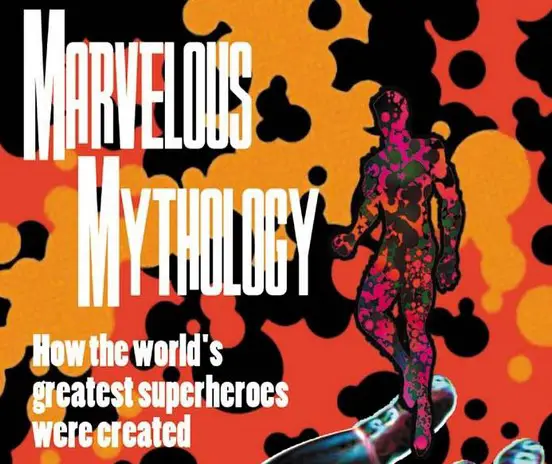Todd Frye’s slim, self-published Marvelous Mythology: How the World’s Greatest Superheroes Were Created seems at first blush another attempt to capitalize on pop culture’s current infatuation with Marvel Comics characters, but it takes a different enough approach that it can still find a spot in a crowded field.
Marvelous Mythology: How the World’s Greatest Superheroes Were Created

Mythology sidesteps much of the behind-the-scenes type stuff found in other recent, more gossipy accounts like Marvel Comics: The Untold Story and The Secret History of Marvel Comics in order to get to “the good stuff,” as Frye says. The book attempts to provide a historical perspective of how and when Marvel’s most famous characters were introduced and developed, with a greater emphasis on the OGs of the early ‘60s.
That still might sound like a Wikipedia-style info dump, but Frye effectively weaves everything together chronologically so that the reader can better understand what it must have been like during the early days. By 1957, publisher Martin Goodman could only print eight titles a month, as his new distributor had a stake in DC Comics and saw their deal as a way to keep competition suppressed. This made it a lot easier to consume everything Marvel produced, and necessitated split titles like the now-legendary Strange Tales and Tales to Astonish in order to keep the flood of new characters fresh in people’s minds.
Goodman sold the company in 1968 for a whopping $15 million dollars, a testament to how much Stan Lee, Jack Kirby and Steve Ditko – almost solely – created and honed in the seven short years after Fantastic Four #1. This paved the way for an explosion of new titles, but Marvelous Mythology emphasizes just how important FF was during that time period, when it boasted the best talent and most intricate stories; a stark contrast to the present day, when Marvel’s First Family is all but absent. Still, we’re reminded that even the greats had a learning curve, as all of Lee’s early characters spoke in Brooklyn slang and found few more antagonists than communists or spacemen, or communist spacemen (hello, Red Ghost).
There’s no original research or reporting in Mythology, and the book can suffer at times for that, as when Frye speculates why the debut of Spider-Man was famously shoehorned into the final issue of “Amazing Fantasy.” You do get a few “insider” tidbits here and there, such as Goodman’s “pump and dump” strategy of riding the crests between trends to keep the cash flowing, or how the Marvel Method of writing was crystallized because artists Jack Kirby and Steve Ditko weren’t all that fond of interacting with Stan Lee.
But that’s not the main aim of the book, and I don’t think it’s necessarily meant to appeal to fans dabbling in the cinematic universe, either. I’d expect illustrations if that were the case, though it’s easy to understand the prohibitive costs and hassle that keep them out of Mythology. Without them, though, the volume feels kind of like a research paper, and the lack of something as simple as chapter names doesn’t help that impression.
The fact that Frye lays things out fairly plainly so that you can draw a line of provenance from 1961 through today may instead be more valuable for seasoned comic fans who sometimes find it hard to reconcile the modern widescreen storytelling with the four-color funnies that birthed a genre. For those who tire of hero vs. hero smackdowns, it might be good to remember how the Avengers were at each other’s throats from day one. As our wallets groan at new price increases, the pain is lessened slightly when noting the doubling of costs between 1969 and 1974.
Despite the balance of attention being seemingly off in some spots – a Guardians of the Galaxy section might be out of place, and there’s surprisingly little X-Men talk – Marvelous Mythology ties a bow on the House of Ideas’ most important concepts in a linear fashion that one would be hard-pressed to achieve just bouncing between Wikipedia entries. Frye’s book could serve as a good companion for the hardcore fan looking to dive into Marvel Digital Comics Unlimited, or something similar, and connect the original dots.
Marvelous Mythology is 224 pp. and is currently available as an eBook on Amazon, Barnes & Noble and other channels, with a paperback version, retailing for $19.99, available at MarvelousMythology.com and elsewhere beginning on January 20.
Join the AIPT Patreon
Want to take our relationship to the next level? Become a patron today to gain access to exclusive perks, such as:
- ❌ Remove all ads on the website
- 💬 Join our Discord community, where we chat about the latest news and releases from everything we cover on AIPT
- 📗 Access to our monthly book club
- 📦 Get a physical trade paperback shipped to you every month
- 💥 And more!












